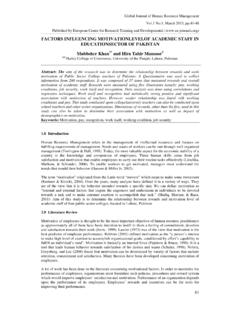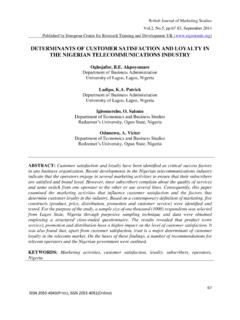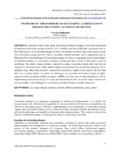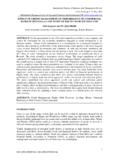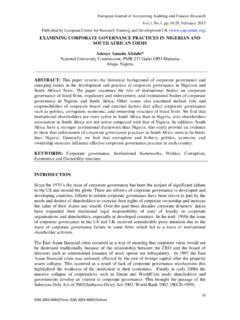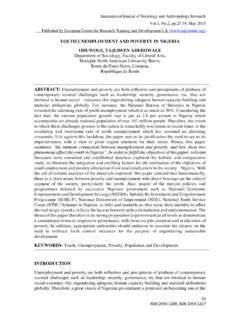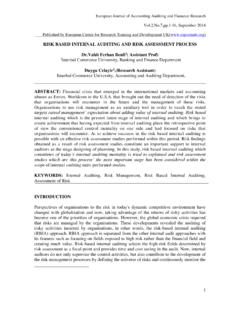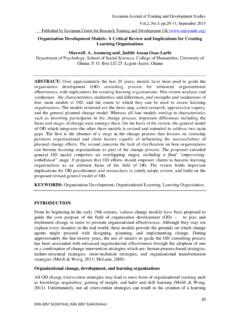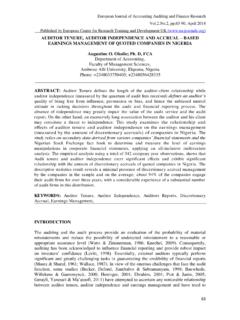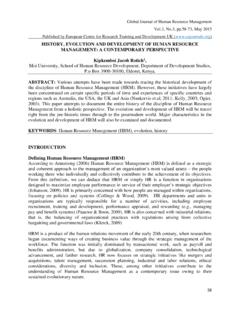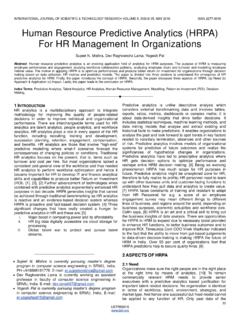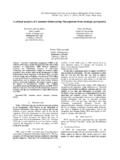Transcription of FACTORS THAT PREDICT EMPLOYEE RETENTION IN PROFIT …
1 Global Journal of Human Resource Management , , , December 2014 Published by European Centre for Research Training and Development UK( ) 1 ISSN 2053-5686(Print), ISSN 2053-5694(Online) FACTORS that PREDICT EMPLOYEE RETENTION IN PROFIT AND NOT-FOR- PROFIT ORGANIZATIONS Sunia Fukofuka, PhD. Program Director of Online MBA and Distance Learning Center Business Department Adventist International Institute of Advanced Studies, Lalaan 1, Silang 4118, Cavite, Philippines ABSTRACT: RETENTION of talent is critical to maintaining a competitive advantage (Hatum, 2010). Therefore, understanding the FACTORS that impact RETENTION is necessary for all organizations (Brown & Yashioka, 2003; Sinha & Authour, 2012). In this study, a cross sectional survey design was used to understand how mission attachment, organizational commitment, and EMPLOYEE engagement predicts EMPLOYEE RETENTION . The participants for this study come from employees of not- for - PROFIT and for- PROFIT organizations in Silang Area, Cavite, Philippines.
2 Multiple regression analysis was used to establish the best predictive model from the above-mentioned variables and it was found that mission attachment, organizational commitment, and EMPLOYEE engagement predicts EMPLOYEE RETENTION for both organization types. Recommendations based on the results will be discussed. KEYWORDS: EMPLOYEE RETENTION , PROFIT , Not-For- PROFIT Organizations INTRODUCTION Critical to the survival and competitiveness of the organization is its ability to attract and retain talent. In a world where globalization has enabled organizations to head hunt talent from around the globe, it is essential that organizational leaders understand the FACTORS that influences employees willingness to stay within the organization (Brown &Yashioka, 2003; and Sinha &Authour, 2012). The reason is simple, people has always been the edge for the successful organization (see Messmer,et .al., 2008). As such, to be competitive, to be the top in the industry, organizations must figure out how to attract and retain its talent.
3 Unfortunately, RETENTION of key employees is still a challenge today (see Veloso et. al., 2014). FACTORS such as excessive workload, job stress, accountability requirements and financial uncertainties have challenged both PROFIT and non- PROFIT organizations in their attempt to hold on to their skilled employees (McDonald as cited in Kim & Lee, 2005). Hence different constructs have been used in the literature in an attempt to understand RETENTION better. Key to this study are the following constructs: EMPLOYEE engagement, organizational commitment, and mission attachment. Specifically, the focus of this study was to find out the ability of EMPLOYEE engagement, organizational commitment, and mission attachment to PREDICT EMPLOYEE RETENTION . Organizational Commitment Organizational commitment is not a new construct and most in the literature subscribes to Allen and Meyer s (1990) definition that organizational commitment is the psychological state that Global Journal of Human Resource Management , , , December 2014 Published by European Centre for Research Training and Development UK( ) 2 ISSN 2053-5686(Print), ISSN 2053-5694(Online) binds the individuals to the organization (p.)
4 14). Allen and Meyer (1990) theorized that organizational commitment has three dimensions: affective commitment due to emotional attachment identification, and involvement with the organization; continuance the EMPLOYEE being committed due to the organization because of the recognition that other options outside of the organization would be worse; and normative commitment the commitment based on an obligation to the organization. Curtis and Wright (2001) believe that organizational commitment is the first most important construct in terms of EMPLOYEE RETENTION . Others also have argued that organizational commitment has a greater effect on EMPLOYEE RETENTION than other constructs (see Slugoski, 2008 on job satisfaction and embeddedness). Regardless of how it is perceived, the literature is in agreement in that where employees organizational commitment is high, the likelihood of RETENTION is high. On the other hand, if the EMPLOYEE s organizational commitment is low, the likelihood of RETENTION is low (Barling& Cooper, 2008).
5 Hypothesis1: There is a relationship between organizational commitment and RETENTION EMPLOYEE Engagement Kahn (1990) argued that EMPLOYEE engagement is the harnessing of the organization members selves to their work role in engagement as people employ and express themselves physically, cognitively, and emotionally during role performance (p. 694). This means the EMPLOYEE going an extra mile in terms of their discretionary use of time, brainpower and energy (Fineman& Carter as cited in Schweyer, 2009, p. 4). Implicit in the above definitions is the understanding that the primary purpose of engagement is perhaps not RETENTION . When employees are engaged, they will perform better here is a distinction between EMPLOYEE engagement and organizational commitment an EMPLOYEE can be committed to the organization and not be engaged. However, it is difficult for the opposite to be true, an EMPLOYEE engaged in the organization is likely to be committed to the organization.
6 As such, although the primary purpose of EMPLOYEE engagement may not have been RETENTION , the argument is if an EMPLOYEE is engaged to the organization, the organization has a better chance of retaining that EMPLOYEE . Hypothesis 2: There is a relationship between EMPLOYEE engagement and EMPLOYEE RETENTION Mission Attachment The mission statement of an organization is a declaration of the reason why organization exists as well as its purpose. Mission attachment therefore can be defined as the fit between employees and the organizational mission as observed in its mission statement (Brown &Yashioka, 2003). Mission attachment have been studied in terms of RETENTION in not for PROFIT organizations (see Kim & Lee, 2005; Brown &Yashioka, 2003; Rycraft, 1994) and these studies suggest that employees are tied to their organizations based on the fit between the employees and the organizational mission. In other words, employees are retained by the organization not so much because of benefits acquired from the organization but rather that the employees are attached to the mission of the organization.
7 Therefore, it can be argued that if employees are attached to the mission of the organization, the organization has a better chance of retaining the EMPLOYEE Global Journal of Human Resource Management , , , December 2014 Published by European Centre for Research Training and Development UK( ) 3 ISSN 2053-5686(Print), ISSN 2053-5694(Online) Hypothesis 3: There is a relationship between mission attachment and EMPLOYEE RETENTION . EMPLOYEE RETENTION EMPLOYEE RETENTION is the ability of an organization to reduce the turnover of its organization. Sinott, Madison, and Pataki (2000) argues that an effective EMPLOYEE RETENTION consists of a systematic effort to create and foster an environment that encourages employees to remain employed by having policies and practices in place that address their diverse need (p. 2). This means that organizations should be deliberate in their efforts to induce employees to be committed, attached, and embedded in the organization (Kyi, 2011).
8 As such, the purpose of this study (as was stated above) is to find out whether organizational commitment, EMPLOYEE engagement, and mission attachment can PREDICT EMPLOYEE RETENTION . Further, for practitioner s purpose, it is also important to find out which of organizational commitment, EMPLOYEE engagement, and mission attachment has the higher influence on EMPLOYEE RETENTION . Hypothesis 4: Organizational commitment, EMPLOYEE engagement, and mission attachment PREDICT EMPLOYEE RETENTION For- PROFIT and Not-for- PROFIT Organization Type In doing this study, the researchers decided to study the four constructs in terms of both for- PROFIT and not-for- PROFIT organizations. The purpose for doing this was to understand whether there is a difference between the constructs in terms of organizational purpose. For instance, organizational commitment may be better suited for for- PROFIT organizations RETENTION whereas mission attachment may be better suited for not-for- PROFIT organizations.
9 It is important to understand how these constructs play out in these two different types of organizations because developing of EMPLOYEE RETENTION strategies should be deliberate and organizational context specific (Veloso et al., 2014). Therefore, the predictive model for these two types of organizations would be done separately to see whether there is a difference between the constructs in term of the organization type. Hypothesis 5: There is a difference between the predictive models of for- PROFIT and not-for- PROFIT organizations The Conceptual Framework METHODOLOGY EMPLOYEE RETENTION Organizational Commitment Mission Attachment Employees Engagement Global Journal of Human Resource Management , , , December 2014 Published by European Centre for Research Training and Development UK( ) 4 ISSN 2053-5686(Print), ISSN 2053-5694(Online) The study was achieved using a survey research design. This design is appropriate when seeking out information regarding attitudes, opinions, preferences, feelings, and motives (Fraenkel&Wallen, 2007; Myers & Hansen, 2006).
10 There are two types of survey research design: the longitudinal and the cross sectional survey design. The cross sectional survey design was considered appropriate because it is a one-time testing of the hypothesized model. The target population of this study were employees of for- PROFIT organizations and not-for- PROFIT organizations within the Cavite districts. Convenience sampling was used to select the desired participants but purposive sampling was used to select the organizations that the participants would come from. In terms of the not-for- PROFIT organizations, two not-for- PROFIT organization were selected and 205 instruments were distributed. Of the 205 instruments, only 126 were received from the respondents indicating a 61% response rate. Of the for- PROFIT organizations, 6 organizations were used and 232 instruments were distributed among them of which 188 respondents returned their questionnaires.
